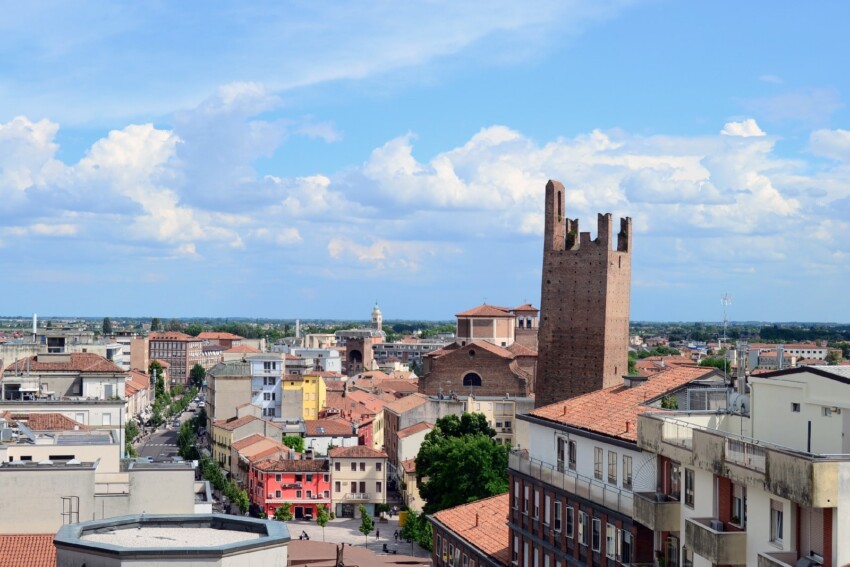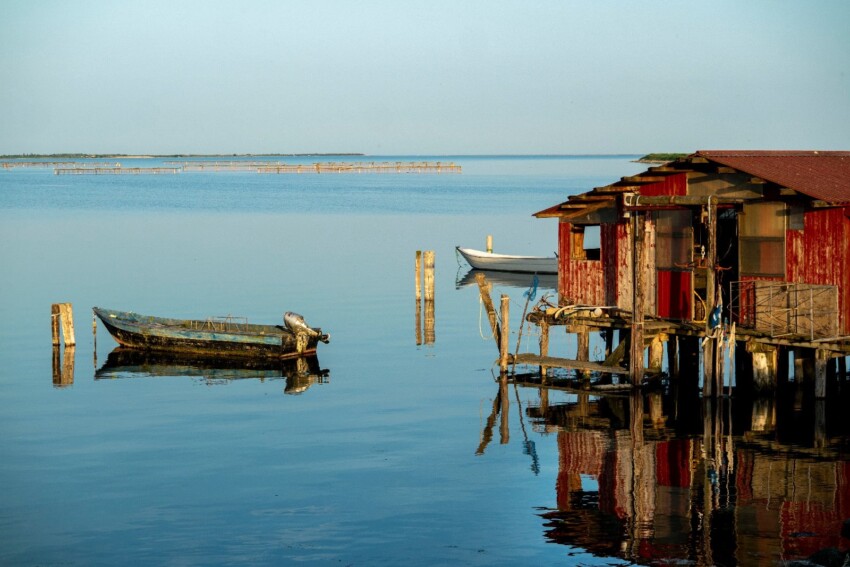

Rovigo sits placidly north of the Po and south of the Adige. No watercourse flows through the city centre, yet water is the defining element of Polesine, a long narrow line of land furrowed by canals and ancient riverbeds that historically corresponds to the province of Rovigo.
It is the least visited capital of the Veneto region, but the indifference of tourists is due more to the international fame of the neighbouring provinces than to a lack of attractions.
It is no less beautiful or less interesting than other similarly sized Italian cities, and lies close to one of our country’s natural wonders: the boundless and little-known Po Delta. Of medieval origin, Rovigo was the domain of the Este family, the Serenissima Republic of Venice and the Austrians.
It has a reputation, and an unflattering one at that. In 2014, a radio survey pinned the title of ‘Italy’s most boring city’ on it, and since then jokes have been wasted on Rovigo’s unbridled nightlife (almost non-existent), the size of its historic centre (tiny), and the fog that shows nothing.
Laugh at the other medium-small towns in Italy. Rovigo can boast a station where Frecciarossa trains stop, original exhibitions that attract visitors from the neighbouring provinces and beyond, a historic theatre and an experimental one, an event founded in 2013 that is already considered one of the 25 most important cultural festivals in Italy (Rovigoracconta), and many splendid destinations that can be reached in a day such as Ferrara, Padua, Venice, and Verona.
Quiet Rovigo is a city on a human scale, easy to get to and around, with more things to see and do than its unfair reputation might lead you to believe. An unusual destination in one of Italy’s most visited regions.
The centre of Rovigo is very small and easy to get around on foot. The main landmarks are the two central squares, Piazza Vittorio Emanuele II and Piazza Garibaldi, and Corso del Popolo, the classic main artery of the centre that is also a favourite shopping street.
The things to see in the centre of Rovigo are all concentrated within a very short distance from these key places. It is worth moving around to see the most interesting attractions in the province.
Roverella Palace is the jewel in the crown of the city’s cultural offerings. The temporary exhibitions held in this palace attract a large audience and are very popular. The topics are varied: art and magic, Japanism, historical jousts, European manga, Marc Chagall…
This elegant palace along the main avenue was built at the end of the 15th century at the behest of wealthy Cardinal Bartolomeo Roverella, eager to show off the prestige his family had achieved. The splendour did not last long: with the death of the cardinal, which occurred only three years after work had begun, construction of the palace came to a halt, and from the late 16th century onwards, the interiors were altered several times without any criteria.
It was not until the end of the Second World War that the palace acquired the splendour that was in the cardinal’s plans. You will have no difficulty recognising its harmonious red brick and pink marble façade and the portico resting on elegant columns.
Besides being the venue for important temporary exhibitions, Palazzo Roverella is also home to an important picture gallery.
The permanent exhibition includes a collection of works of art from the 15th to the 18th century collected over the centuries by noble families from Rovigo; among the artists on display are some of the greatest masters of Italian painting, including Bellini, Vecelli, Tintoretto and Tiepolo.
Opposite Palazzo Roverella stands another historical building in Rovigo that represents an important part of the city’s cultural offer.
More sober and austere than Roverella Palace, Roncale Palace was built in the 16th century at the behest of Giovanni Roncale, a merchant from Bergamo who settled and made his fortune in Rovigo, succeeding in ennobling his family and making it a cornerstone of the Rovigo aristocracy for centuries to come.
The palace currently exhibits part of the picture gallery collection.
A small gem in the centre of Rovigo is the Social Theater, a historic theatre opened in 1819 and still configured as a public institution. It represents one of the few traditional opera houses in Italy and carries out an opera season much loved by the local population, flanked by seasons of prose, dance, concerts, jazz and children’s theatre.
In recent years, the Sociale di Rovigo has modernised its image, which was mainly tied to traditionally staged shows, adding more modern shows to its usual offerings, capable of satisfying a varied audience.
It is possible to participate in guided tours of the theatre by appointment.
A counterpart to the Social Theater is the Studio Theater, a hall dedicated to experimental and avant-garde productions currently managed by the Teatro del Lemming.
With just a 10-minute walk from the main squares of the centre, you can reach a museum entirely dedicated to the peculiarities of the Polesine territory.
Set up in the rooms of the former Olivetan Monastery of San Bartolomeo, the Museum of the Great Rivers in Rovigo makes use of multimedia installations, models, dioramas and archaeological finds to narrate the development of the civilisations that arose on the banks of the Po and Adige rivers.
The tour is divided into five historical periods: the Bronze Age, Iron Age, Roman Age, Middle Ages and Renaissance.
Rovigo also had its own castle: it was erected in 920 by the bishop of the nearby city of Adria; it was part of the defensive fortification that surrounded the historic core of the city and served as the bishop’s seat for the prelate fleeing the Hungarian invasions.
All that remains of the medieval castle of Rovigo are two leaning towers that can be seen in a beautiful garden at the beginning of the pedestrian area of the centre.
The tallest is the Donà Tower (51 metres), but its an easy win because the nearby Grimani Tower lacks the entire upper part (hence the nickname Torre Mozza). The two towers cannot be visited, but it is worth a visit to see them and perhaps take advantage of the park for a little relaxing break.
It is called La Rotonda, but to be precise its shape is octagonal: we are talking about the Church of the Beata Vergine del Soccorso, the most interesting religious building in Rovigo.
Built at the turn of the 16th and 17th centuries, the church has a simple, linear exterior. The interior, on the other hand, is much more opulent and houses valuable 17th-century Veneto paintings; the 1607 altar and 1767 organ are also noteworthy.
The church is surrounded by a large portico and overlooks Piazza XX Settembre, a popular meeting place for young people from Rovigo.
Of the ancient gates of Rovigo, the best preserved is the 15th-century San Bortolo Gate, which still has its Ghibelline battlements almost intact.
The gate gives access from the centre to the San Bartolomeo district, in the southern part of the city.
Just 15 km from the centre of Rovigo, in Fratta Polesine, is an elegant Palladian villa: it is Villa Badoer known as La Badoera, not to be confused with Villa Badoere known as La Rotonda in the province of Treviso. Designed by Andrea Palladio, the brilliant architect from Vicenza to whom the most beautiful Venetian villas are owed, it was the noble residence of a wealthy Venetian family.
It consists of a central body, which served as the owners’ residence, and two barchesse (farmhouses) arranged in a semicircle; the villa was enlarged in the 18th century with the extension of the barchesse (farmhouses). The interior is decorated with elegant frescoes depicting mythological scenes and other decorative motifs taken from classical antiquity.
Currently, one of the two barchesse houses the National Archaeological Museum of Fratta Polesine.

The Po Delta is the wonder of the province of Rovigo: the Italian Camargue, a fascinating marshland of great environmental and cultural importance but still ignored by mass tourism.
Its melancholic beauty has served as the backdrop for some of the most important pages in the history of Italian cinema (think of Paisà, one of the masterpieces of Neorealism), while today it is the setting for wonderful excursions by bike, boat or on foot.
There are many attractions not to be missed in the Po Delta, which is why we have created an in-depth page.
Read moreIn the following map you can see the location of the main places of interest mentioned in this article.
The city does not have a tourist vocation, so there are very few hotels in the centre of Rovigo. It is better to opt for a b&b or even better to move a few kilometres away and stay in an agritourism.
For those who like modern facilities, equipped with all comforts, there is a 3-star hotel of an international chain near the motorway exit.
Rural tourism in the province of Rovigo is attracting growing interest, and there are therefore an increasing number of holiday homes, rooms to let and campsites available for those who want to spend a holiday in the countryside while remaining a short distance from the provincial capital.
Although strategically less important than other Veneto cities, Rovigo is not neglected by the most important transport routes and is therefore easy to reach both by car and public transport.
If you want to reach Rovigo by car, the reference motorway is the A13 Bologna-Padova; the Lendinara-Rovigo Centro exit is less than 4 km from the heart of the city.
The railway station, on the other hand, is located just outside the centre and can be easily reached on foot. Connections to Bologna and Venice are very frequent, provided by regional, intercity and high-speed trains.
Within a radius of 80 km there are four major airports, all served by low-cost airlines: Venice, Treviso, Verona and Bologna.
What's the weather at Rovigo? Below are the temperatures and the weather forecast at Rovigo for the next few days.
Rovigo is the southernmost province of Veneto. It borders Emilia-Romagna to the south and the provinces of Venice, Padua and Verona to the north. The capital city is located in the central-northern part of the province, approximately 70 km from Venice, 40 km from Padua and 80 km from Verona.